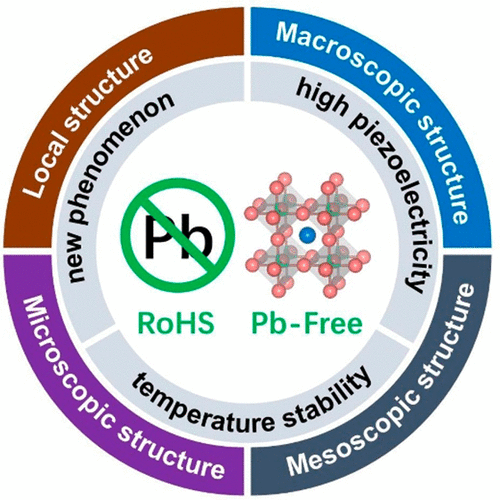当前位置:
X-MOL 学术
›
Acc. Mater. Res.
›
论文详情
Our official English website, www.x-mol.net, welcomes your
feedback! (Note: you will need to create a separate account there.)
Multiscale Structure Engineering for High-Performance Pb-Free Piezoceramics
Accounts of Materials Research ( IF 14.0 ) Pub Date : 2022-03-21 , DOI: 10.1021/accountsmr.1c00280 Xiang Lv 1 , Ting Zheng 1 , Chunlin Zhao 1 , Jie Yin 1 , Haijun Wu 2 , Jiagang Wu 1
Accounts of Materials Research ( IF 14.0 ) Pub Date : 2022-03-21 , DOI: 10.1021/accountsmr.1c00280 Xiang Lv 1 , Ting Zheng 1 , Chunlin Zhao 1 , Jie Yin 1 , Haijun Wu 2 , Jiagang Wu 1
Affiliation

|
The increasing world energy crisis drives humans to harvest the energy in nature as much as possible without heavily damaging the environment. However, most of the energy in nature cannot be used directly. Therefore, pursuing technologies or matter that can directly interconvert different energies has been one of the most cutting-edge fields in science and technology. Such a magic ability exists in true-life piezoelectric materials that generate charge when being given a force and vice versa, rendering them highly promising for energy harvesting and conversion because of the tremendous mechanical energy on the earth, such as tide energy. Thus, piezoelectric materials, represented by the lead zirconate titanate (Pb(Zr, Ti)O3, PZT) family, have been largely used in various traditional and burgeoning fields, such as electronic information, biomedical treatment, and wearable flexible electronic devices, and are one of the most important favorites in multidisciplinary fields. However, Pb is highly toxic. Driven by environmental protection and concern for human health, Pb-free piezoceramics are rapidly being developed to hopefully replace Pb-based ones. In particular, the renewal of Restriction of the use of certain Hazardous Substances (e.g., RoHS 2), issued by the European Union, declared that replacement of PZT “...may be scientifically and technologically practical to a certain degree...”. Therefore, developing high-performance Pb-free piezoceramics has become more urgent than ever. In this context, some Pb-free piezoceramics, represented by potassium sodium niobate ((K, Na)NbO3, KNN), barium titanate (BaTiO3, BT), bismuth barium titanate ((Bi, Na)TiO3, BNT), and bismuth ferrite (BiFeO3, BFO), stand out because of their unique or similar traits. However, several key challenges, including an inferior overall performance compared to Pb-based counterparts and an unclear structure–property relationship from multiscale viewpoints, have severely hindered the development of Pb-free piezoceramics for a long time.
中文翻译:

高性能无铅压电陶瓷的多尺度结构工程
日益严重的世界能源危机促使人类在不严重破坏环境的情况下尽可能多地从自然界中获取能源。然而,自然界中的大部分能量都不能直接使用。因此,追求可以直接将不同能量相互转换的技术或物质,一直是科学技术中最前沿的领域之一。这种神奇的能力存在于现实生活中的压电材料中,当受到力时会产生电荷,反之亦然,由于地球上巨大的机械能,如潮汐能,它们非常有希望用于能量收集和转换。因此,压电材料,以锆钛酸铅(Pb(Zr, Ti)O 3, PZT) 家族,已大量应用于各种传统和新兴领域,如电子信息、生物医学治疗和可穿戴柔性电子设备,是多学科领域最重要的宠儿之一。然而,铅是剧毒的。在环境保护和对人类健康的关注的推动下,无铅压电陶瓷正在迅速发展,有望取代基于铅的压电陶瓷。特别是,欧盟发布的《限制使用某些有害物质(如 RoHS 2)的更新声明》宣布,PZT 的替代“……在一定程度上可能在科学和技术上具有实用性”……”。因此,开发高性能无铅压电陶瓷变得比以往任何时候都更加紧迫。在此背景下,一些无铅压电陶瓷,以铌酸钾钠((K, Na)NbO 3 , KNN)、钛酸钡(BaTiO 3 , BT)、钛酸铋钡((Bi, Na)TiO 3 , BNT)为代表。 ,和铁氧体铋(BiFeO 3,BFO),因其独特或相似的特性而脱颖而出。然而,几个关键挑战,包括与基于铅的对应物相比整体性能较差以及从多尺度角度看结构-性能关系不明确,长期以来严重阻碍了无铅压电陶瓷的发展。
更新日期:2022-03-21
中文翻译:

高性能无铅压电陶瓷的多尺度结构工程
日益严重的世界能源危机促使人类在不严重破坏环境的情况下尽可能多地从自然界中获取能源。然而,自然界中的大部分能量都不能直接使用。因此,追求可以直接将不同能量相互转换的技术或物质,一直是科学技术中最前沿的领域之一。这种神奇的能力存在于现实生活中的压电材料中,当受到力时会产生电荷,反之亦然,由于地球上巨大的机械能,如潮汐能,它们非常有希望用于能量收集和转换。因此,压电材料,以锆钛酸铅(Pb(Zr, Ti)O 3, PZT) 家族,已大量应用于各种传统和新兴领域,如电子信息、生物医学治疗和可穿戴柔性电子设备,是多学科领域最重要的宠儿之一。然而,铅是剧毒的。在环境保护和对人类健康的关注的推动下,无铅压电陶瓷正在迅速发展,有望取代基于铅的压电陶瓷。特别是,欧盟发布的《限制使用某些有害物质(如 RoHS 2)的更新声明》宣布,PZT 的替代“……在一定程度上可能在科学和技术上具有实用性”……”。因此,开发高性能无铅压电陶瓷变得比以往任何时候都更加紧迫。在此背景下,一些无铅压电陶瓷,以铌酸钾钠((K, Na)NbO 3 , KNN)、钛酸钡(BaTiO 3 , BT)、钛酸铋钡((Bi, Na)TiO 3 , BNT)为代表。 ,和铁氧体铋(BiFeO 3,BFO),因其独特或相似的特性而脱颖而出。然而,几个关键挑战,包括与基于铅的对应物相比整体性能较差以及从多尺度角度看结构-性能关系不明确,长期以来严重阻碍了无铅压电陶瓷的发展。









































 京公网安备 11010802027423号
京公网安备 11010802027423号